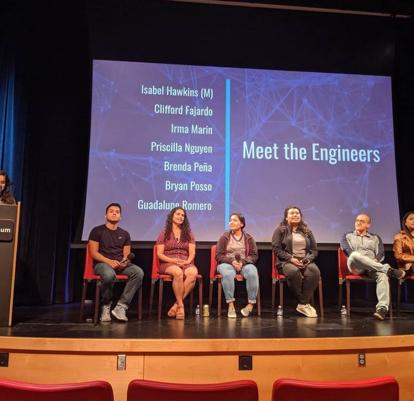Community colleges play key role in adding diversity to STEM
High school outreach programs and clubs such as SHPE connect underrepresented students to STEM careers

During the Society of Hispanic Professional Engineers’ Noche de Ciencias, students and parents learn about the journey to become an engineer. (Photo from prior event courtesy of SHPE)
Vaccines. Climate change. Mars. Cloud robotics. LiDAR. The future is powered by science. Scientists and engineers are working together to create a different-looking world. However, the population of those in the STEM field doesn’t look like the general population. The STEM community is still dominated by white cisgender men.
According to the study “Diversity in the STEM workforce varies widely across jobs” conducted by Pew Center for Research, African Americans make up 11% of the workforce, but only 7% of all STEM workers. Hispanics are 17% of the workforce but only 7% of all STEM workers. 69% of all STEM workers are white.
Community colleges can play a large role in equalizing the playing field and changing the future of the STEM fields. At American River College, there are programs and clubs that connect black, indigenous or people of color (BIPOC) students to the STEM fields and to each other.
The ARC chapter of the Society of Hispanic Professional Engineers is one such club. SHPE provides a community for Hispanic engineering students to connect with each other, collaborating on projects even during COVID-19.
“It feels like family, with that sense of belonging that we lack sometimes,” said Silvia Lizbeth Garcia, SHPE president. “Having people who understand how it is, makes it more comfortable.”
When Garcia came up with a project for a hydroponic 5-gallon bucket garden, other student engineers within SHPE contributed to the project within their own fields with coding, software programming or research.
In non-pandemic times, SHPE also holds frequent Noches de Ciencias for middle school and high school students. Each chapter targets a school and holds these family science nights each semester with hands-on STEM activities. These are targeted to get more Hispanic students interested in going to college for STEM careers, as providing information for parents on how to get their kids to college.
“I had never seen a female engineer [as a child],” Garcia said “If we don’t see it, we don’t think it’s possible. Representation is a big thing.”
Outreach at the high school level is an important step in gathering interest in the STEM fields, according to Jennifer Neale, professor of natural resources at ARC. Pre-pandemic, Neale also worked on many outreach programs to entice students into the ARC STEM programs. Neale worked in particular with Grant-Union High School, participating in high school events and giving presentations to reach a diverse future student population.
“Connecting with secondary schools is critical as that is where many of our students will come from, and if we don’t reach out to them it is likely they would never know about the existence of our programs,” Neale said.
Neale has also partnered with other ARC groups such as Umoja-Sakhu to increase diversity in the STEM classes, as well as collaborating on a forest restoration project with a local Native American tribe to increase Native American student representation as well.
“The field of Environmental Sciences (like many in STEM) is still dominated by white men, in large part, and that is something that has to change,” Neale said in an email
In the classroom, Neale uses case studies to highlight BIPOC and women scientists at different stages of career development. She also brings diverse guest speakers to the classes and brings up difficult topics such as “being black in nature.” Discussing some of the challenges that BIPOC scientists have to face helps empower students to change the future of STEM.
Getting an early start in STEM even before community college is important, but another important way community colleges can help equalize the playing field is by creating similar opportunities as the students who went straight to a four-year college.
For example, the Sustainable Interdisciplinary Research to Inspire Undergraduate Success project was created by the Sacramento State science department for Sacramento State undergraduates to have research and lab opportunities. The SIRIUS project was to create Authentic Learning Experiences, or ALEs, for undergraduate students.
These ALEs focus on research on the American River. The students from multiple disciplines gather information on the American River and log the information into a data bank. This project-based learning gives students a strong background in research and lab work.
When aspiring scientists start to apply for jobs in their fields, this strong background can make them stronger candidates, but students who transferred from community college to a four-year college can miss out on these opportunities.
In October 2020, the SIRIUS II grant was funded so the Los Rios college system can take advantage of the same opportunity. Soon, ARC students can also get the research experience needed for their future, according to Linda Zarzana, professor of chemistry at ARC. Zarzana is the key professor behind the SIRIUS II grant.
“This would give ARC students comparable skills and strategies, so they don’t feel behind,” Zarzana said.
Part of the grant is to get more students motivated in careers in STEM. That includes specific outreaches to impacted communities, such as mentorship programs and faculty training. The faculty training will address adding equity in the curriculum and how to address barriers to pursuing a career in STEM.










